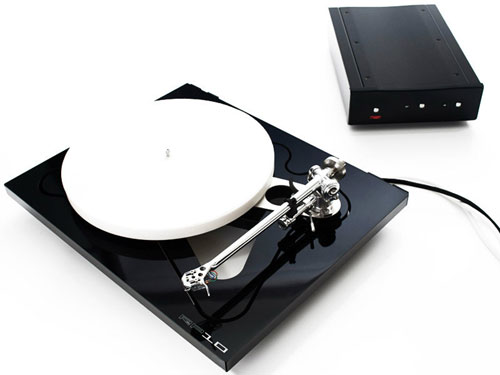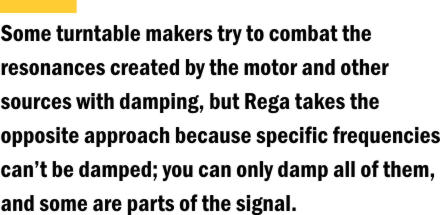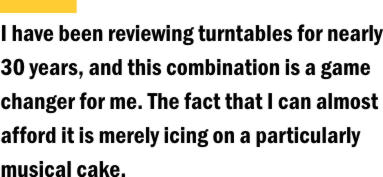Rega
• RP10 Turntable
Rega's top-of-the-line turntable isn't about "sound quality." It's about "more music."
hen I visited Rega Research's facility at Southend on Sea, Essex, in the east of England, a couple of years ago, they were playing with a prototype chassis for an ultimate turntable. That model, the Naiad, has yet to be finalized, but the company has sold the first 40 of them. The RP10 ($5495) is the nearest thing you can get to a Naiad, with which it shares a number of features. The platter, for instance, is ceramic, and the chassis is uncannily rigid and skeletal, to keep its weight to a minimum.
I originally wrote "absorbs the energy," but having checked the physics with Rega, I discovered that this is not the case. Remove the platter from an RP10 and you have an extremely low-mass piece of machinery; remove the motor, bearing, and tonearm, and the thing might float away. Yet the plinth is extremely stiff -- made of cellular polyolefin foam between skins of phenolic resin, it’s the ultimate incarnation of Rega’s plinth design of a stressed skin over a lightweight core. The skeletal chassis can be used alone, or placed within a rectangular outer plinth that provides an anchor for the dustcover. Because the smaller chassis is located with O-rings, it remains independent of the outer plinth. This makes the RP10 both a practical and, as we shall see, very high-performance turntable, which is a rare combination indeed. The RP10 differs from the RP8 in having Rega’s all-metal RB2000 tonearm, a ceramic rather than a glass platter, and a much more substantial external power supply. The latter inhabits a case the size of Rega’s Brio-R integrated amplifier and can remain permanently powered up without the motor running; all other Rega power supplies are on only when the platter is spinning. The RP10’s power supply has a new antivibration-and-speed-control circuit to drive the 24V AC motor, and uses DSP and a high-stability crystal reference to provide the motor with the precise frequency to achieve correct speed. Each power supply is tuned to its partnering motor for minimum vibration and maximum speed accuracy. The RB2000 tonearm has a precision-engineered, aluminum-alloy vertical bearing assembly in place of the plastic one found on other current Rega 'arms. Roy Gandy prefers metal to plastic because it’s stiffer, and his sales department prefers it because it improves the 'arm’s appearance and the perception of quality. With the RB2000, Rega takes their scrupulous selection of bearings to a new level. Not only are the bearings the best of the bunch, but each is selected for best fit with the spindle it runs on. The whole thing is polished, to minimize weight and improve appearance, and comes supplied with a tungsten counterweight because its smaller size (compared to steel) reduces the moment of inertia: Big flywheels work better than small ones even of the same mass; if you want a mass that you can control, smaller is better. As ever with Rega 'arms, the vertical tracking angle (VTA) is fixed; in Rega’s books, keeping the movement to a minimum is more important than tweaking the tonal balance.
The white platter, designed to create a flywheel effect, is made of compressed ceramic-oxide powder that is fired and diamond-cut to ensure the accuracy of its shape. It resembles the platter used in Rega’s earlier range topper, the RP9, but has fewer sharp edges and better coupling to the subplatter. Gandy chose a platter of ceramic because it’s an extremely stiff, heavy material that can be accurately machined, and comes closer to the ideal than the alternatives. It’s topped, as ever, by a record mat of pure wool, because this gets closest to the ideal of maximum support with minimum spring, and couples the record to the platter. first used the RP10 with Rega’s Apheta moving-coil cartridge ($1795), which is available at a discount when purchased with the RP10, for a combined price of $6495. This cartridge has the advantages of very low mass and a third fixing point at the front when used with a Rega tonearm. It has also been designed to work in the RB2000 'arm, which makes it a natural choice for the RP10. I plugged the WBT-style RCA plugs (with clamping collet) into a Trilogy 907 moving-magnet/moving-coil phono stage and set the impedance to the desired 100 ohms. This was connected to a Townshend Audio Allegri passive controller, ATC P1 power amplifier, and PMC fact.8 loudspeakers with Townshend Fractal and Chord Sarum TA interconnects and Townshend Isolda DCT speaker cables. The turntable sat on a highly damped Townshend Seismic stand, but this didn’t stop it from delivering a performance that got right under my skin and wouldn’t let go. The RP10 proved such a severe distraction that I became a vinyl junkie of the first order, a state that has afflicted me on occasion in the distant past, but one that I thought I had under control. It did this by unearthing vast amounts of information from the groove and presenting it in such a coherent manner that I heard a lot more signal and a lot less of the turntable than usual. It was possible to appreciate exactly how each instrument was being played, whether alone or in a large band. I could focus on the work of each musician, or simply sit back and enjoy the whole composition -- the full effect of their combined efforts. Thus, my notes rarely referred to sound quality per se, but were full of references to the style of playing and singing, the venues and recording character. This, ultimately, is what high-fidelity equipment is designed to do, but somewhere along the line audiophiles got distracted by sound quality, because it is possible to make audio components that produce euphony: colorations that make the music sound sweeter, more powerful, more rich, even more dynamic, but are not necessarily true to what’s on the recording, and are ultimately detrimental to the music itself. With the RP10, some of the more appealing-sounding records in my collection lost some of their sheen, because the emphasis was not on the sound but on the music. If the music does not speak to you, then you are basically creating aural wallpaper. It sounds pretty, but it won’t communicate the message, won’t let you hear what the musicians are trying to say. Music is, after all, a language that cannot be translated into words. Rega has always had this music-first approach; this is why their finest turntable to date is the apotheosis of musicality. In audiophile terms, it has remarkable temporal precision that is not achieved with brightness that emphasizes leading edges, but is the result of removing overhang. Notes stop when they should, and do not continue to ring or resonate. This was true across the audioband. Most turntables can keep control at high and mid-frequencies, but few can do so in the bass without cutting out the lower registers to create a sense of tautness. The RP10 was capable of prodigious bass -- several records shocked me with the low-end energy being produced -- but it was always under control, detailed, textured, and solid. "Superstition," from Stevie Wonder’s Talking Book [Tamla 319], usually overwhelms turntables with its thick bass synth, but for the first time, the bass line became the center of the rhythm, the anchor for the whole tune -- and what a tune! "Higher Ground," from his Innervisions [Tamla 326], is pretty damn spectacular too; on the Rega, it shook off any sense of thickness and expanded well beyond the speakers to occupy the full width of the room -- and there’s a lot going on out there on the periphery. At this point I could wait no longer and put on some ZZ Top: "I’m Bad, I’m Nationwide," from DegŁello [Warner Bros. 3361], a move that prompted the phrase "Sweet Jesus!" to pass my lips. Suddenly, there was much more music coming out of the system. The burr of Billy Gibbons’s guitar and the syncopation of Frank Beard’s and Dusty Hill’s rhythms were revealed to be even greater than I had ever imagined. I could see it was going to be a long night. It turned out to be three weeks of long nights, sitting eyes closed in front of the system and digging out all the best music in my collection -- a major distraction and a whole lot of fun. I believe the term destination experience about covers it. I also tried a more exotic cartridge, a van den Hul Condor XCM Gold, along with a Trichord Delphini phono stage. This produced more tonal richness than the Apheta-Trilogy pairing, but was not as hot in the timing department, and thus less engaging. The Condor’s higher mass was probably to blame -- that and the fact that it wasn’t specifically designed to partner with a Rega tonearm. You can’t beat designed-in synergy.
There is no record player that times
better than the RP10 with Apheta cartridge, and few that reveal as much detail or have the
same dynamic range. I have been reviewing turntables for nearly 30 years, and this
combination is a game-changer for me. The fact that I can almost afford it is merely icing
on a particularly wonderful musical cake.
|
|||||||||||





